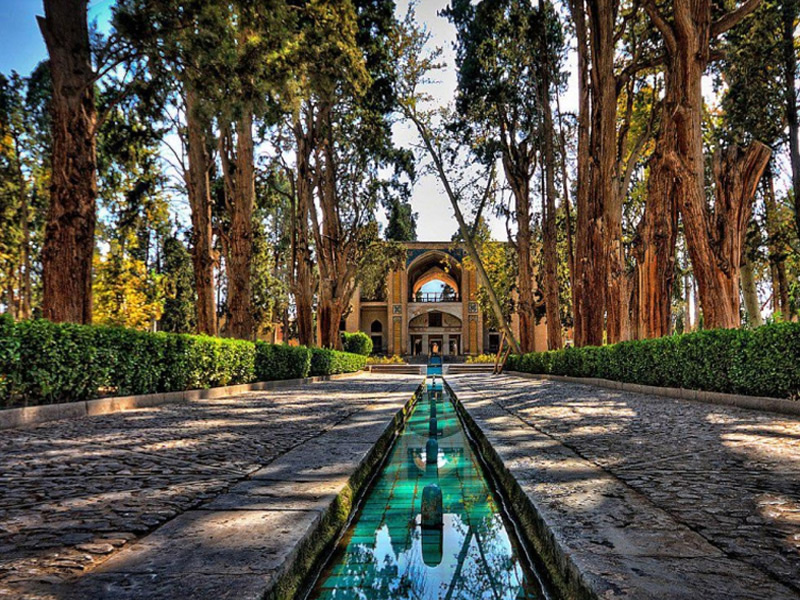Fin Garden, located in the Fin district of Kashan, is one of the most famous and renowned gardens in Iran. It is an exceptional example of Iranian garden architecture, combining history, architecture, and nature harmoniously. The garden’s significance has been recognized internationally, as it is listed as a UNESCO World Heritage site.
Entering Fin Garden Kashan, visitors are immediately captivated by its mesmerizing beauty. The garden features towering trees, various fountains of different sizes, and the soothing sound of water flowing through stone pavements. These elements come together to create a tranquil and enchanting atmosphere.
Covering an area of 33,700 square meters, Fin Garden Kashan showcases the architectural heritage of Iranian castle gardens. The central courtyard is encompassed by walls, canals, and cylindrical towers. The use of these structures not only adds to the aesthetic appeal of the garden but also provides a sense of security and refuge for residents. The grandeur and majesty of the kings are evident in the volume, shape, and height of these architectural features.
Book Iran Air flights from London to Tehran and Tehran to London with Eligasht UK:
The philosophy of naming the Fin Garden in Kashan
Previously known as “Shah’s Garden,” the name Fin Garden refers to its location in the Fin district of Kashan. The word “Fin” is derived from “Finah,” which was the name of the hats worn by the people of this region. The garden’s name change reflects the prominence and recognition it has gained over time.
Fin Garden Kashan is a testament to the timeless beauty and enduring architectural principles of Iranian gardens. Its inclusion in UNESCO’s list of World Heritage sites serves as a testament to its cultural and historical significance. Exploring the garden allows visitors to immerse themselves in the rich heritage and captivating natural surroundings that make Iranian gardens truly extraordinary.
Fin Garden Kashan, due to its historical importance and high value, was registered in the National Heritage List of Iran in 1314 (1935) for better protection and preservation.
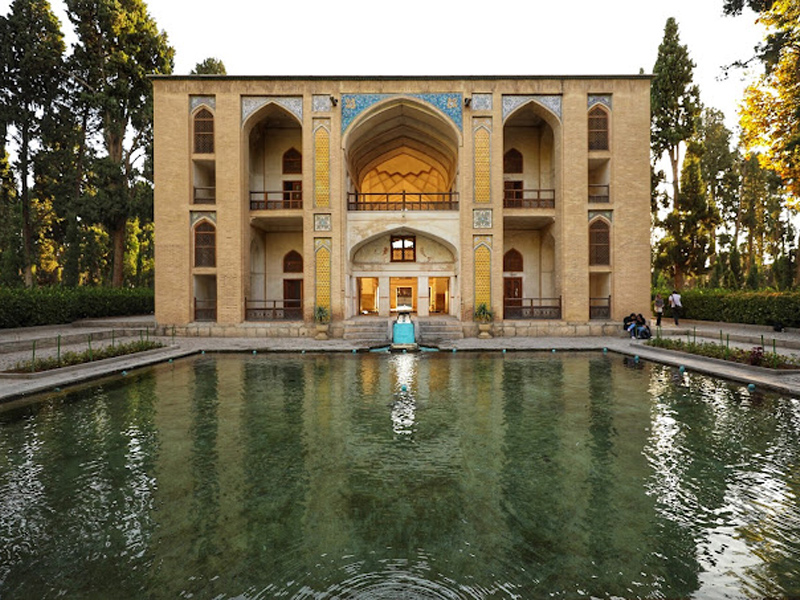
Architecture of Fin Garden Kashan
From an architectural standpoint, Fin Garden Kashan adheres to all the standard principles of garden construction. What stands out the most in this garden is the presence of water and trees, which are the living and captivating elements of this place. They have created an interesting architectural space alongside the structures within the complex. One important element used in the design of this garden is symmetry, which had special significance at that time but gradually decreased with the intervention of the ruling kings of the city. The highest level of asymmetry in this garden occurred during the Safavid era.
The pathways of the garden also play an important role in the garden’s architecture. The central longitudinal axis of the garden runs through the middle, in a northeast-southwest direction, leading to the main entrance of the garden in the northern section.
The east-west pathway is one of the main pathways of the garden, with the National Museum of Kashan and the Amir Kabir Library located on either side of it.
The north-south pathway starts from the Sardar Mansion. The secondary pathway of the garden extends from south to north, starting from the Shotorgelu Mansion on the southern side and ending at one of the secondary entrances of the garden on the northern side.
According to available documents and the announcement of the Cultural Heritage Organization of Iran, the creator of the Fin Garden in Kashan is Ghias al-Din Jamshid Kashani, who designed and constructed the structure of this garden during the reign of Shah Abbas I.
Reason for the Use of Water Element in Fin Garden Kashan
The main reason for the use of the water element in Fin Garden Kashan is to bring tranquility through the sight of water, to cool the air in summer, and to create the resonance of water music, especially in non-residential areas.
There are two beautiful ponds in this complex:
The “Jush” Pond
One of the ponds within this historical complex is the “Jush” Pond, which is truly remarkable. The “Jush” Pond is very attractive, and the reason for that is its carpet-like floor, resembling the famous “Mehrab” carpets of Kashan. The tiles of this pond are made of “Zarin Fam” type and were crafted by the Abi Taher family, who were renowned tile makers in Kashan. Gold was used on the glaze of these tiles. These tiles existed in the pond until the reign of Reza Shah when a group of looters called the “Naibis” attacked the pond and stole its tiles. Later, many people attempted to restore and repair the pond, but none of them were successful.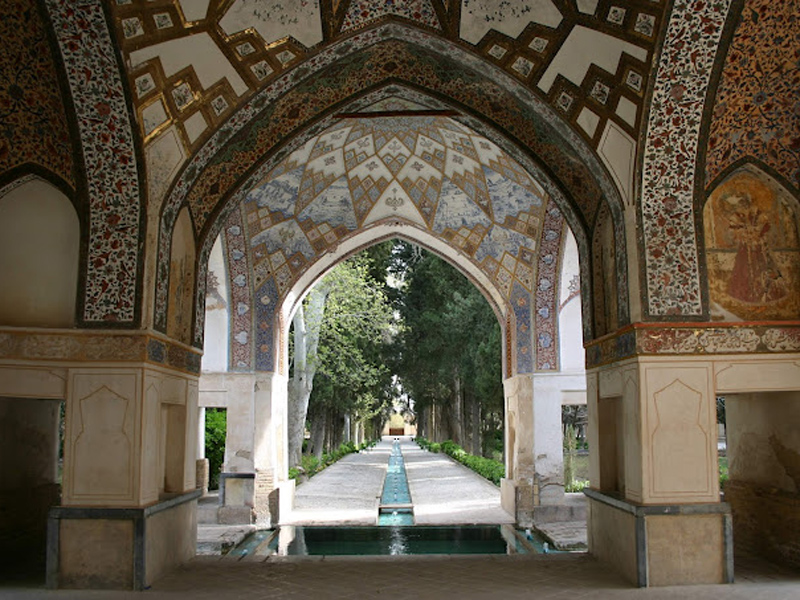
Interesting Function of the “Jush” Pond in Fin Garden Kashan
In Fin Garden Kashan, there are 160 holes in the pond, each representing a flower on the carpet. The function of these holes is that if the first hole acts as a fountain, the second hole performs the water suction. In this way, there are approximately 80 fountain holes and 80 suction holes in these ponds, which help maintain the uniformity of water inflow and outflow, preventing overflow. Today, the overflow water from these ponds passes through three tile tables in the middle of the garden’s pathways.
The “Davazdah Favareh” Pond
This pond was built during the reign of Mohammad Shah Qajar and was constructed simultaneously with the “Jush” Pond and the King’s Chamber in this garden. Today, it is known as the “Davazdah Favareh” Pond. Inside this pond, some fountains represent the Iranian garden structure and architectural masterpiece of the distant past, creating a vertical flow for the water inside the pond without the need for any external force.
Different Sections of Bagh-e Fin in Kashan
1. Fin Bathhouse:
One of the most famous sections of Bagh-e Fin is related to two bathhouses located within the garden. Although their names are not Fin, they are famous by this name due to their location in Fin Garden. The main reason for the fame of these bathhouses is the assassination of Amir Kabir, the prime minister of that time, which took place in one of these baths.
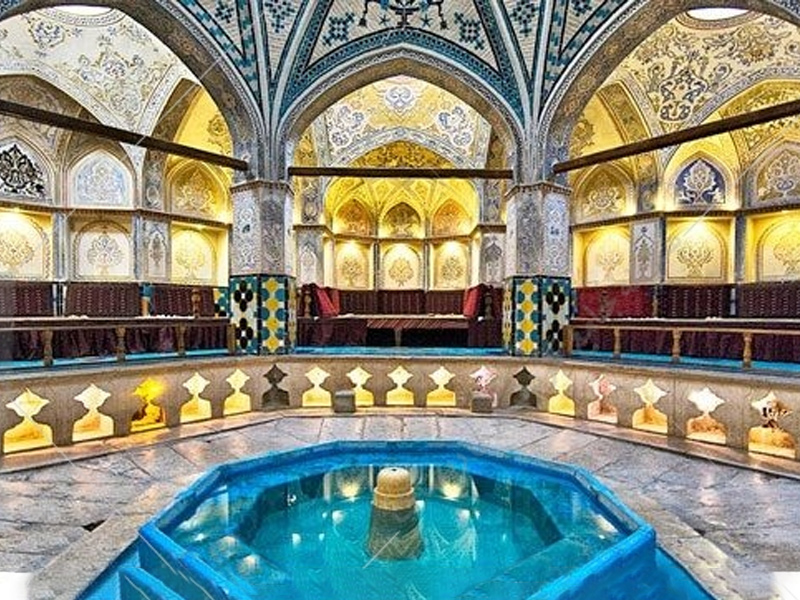
2. Safavid Pavilion:
Another captivating structure in Bagh-e Fin is the Safavid Pavilion, built around 986 AH (Shamsi calendar). This historical building was constructed by the order of Shah Abbas and under the supervision of Agha Khezr Nahavandi, the ruler of Kashan at that time. The pavilion used to have four floors in the past, with the upper two floors resembling a conical hat. However, the earthquake of 1156 caused significant damage, and during the reconstruction, only two floors were built. Today, this building stands at a height of 14 meters and is constructed with materials such as stone for the foundation and raw bricks for the walls. It is highly recommended to visit the interior of this historical and remarkable structure.
3. Shahneshin room:
There is a room known as the “Shahneshin” within the garden, which was constructed around 1218 AH (Shamsi calendar) by the order of Mohammad Shah Qajar. Surrounding this chamber, there are rooms called “Gushvareh” that used to serve as quarters for the chamber’s staff. Out of respect for the Shah, all formalities were conducted through the side doors, and the main door was never used to enter this chamber. Ceremonies of that time took place in front of the windcatcher, the central part, and before the pond of this building.
4. Tea House:
Adjacent to the Shah’s Chamber and next to the Qajar Pavilion, there is another structure called the “Tea House,” which was previously known as the “Feminine Spring.” In this section, all the incoming water to the garden is divided, and one-third of the main spring water flows into it, branching out into three paths and continuing its course through the garden.
5. Qajar Pavilion or Shotorgelu-ye Fathali Shahi:
Another building within Bagh-e Fin is the Qajar Pavilion, constructed by the order of Fath Ali Shah in 1189 AH (Shamsi calendar). It is also known as Shotogelu-ye Fathali Shahi or Sofe-ye Fathali Shahi. This structure consists of various sections, including a pool area and four chambers.
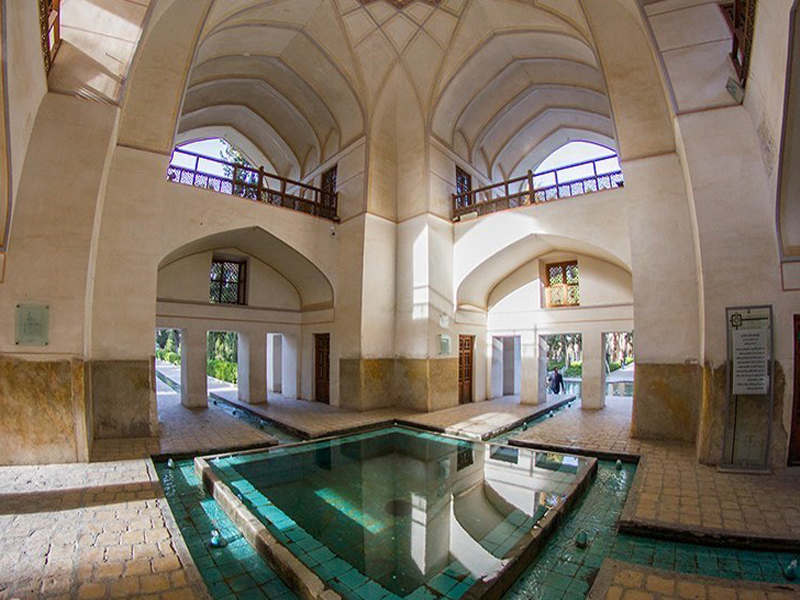
6. Karim Khan’s Private Courtyard:
In a part of Bagh-e Fin, there is Karim Khan’s Private Courtyard, built by the order of Karim Khan and under the supervision of Agha Salim Arani. This section includes a small courtyard, five-door rooms, and simple chambers. Its construction dates back to approximately 1141 AH (Shamsi calendar).
7. Kashan National Museum:
Lastly, within Bagh-e Fin, there is the Kashan National Museum. It was established in 1346 AH (Shamsi calendar) by the efforts of the late Seyyed Mohammad Taghi Mostafavi, the then Director-General of Antiquities. The museum is divided into three sections: archaeology, ethnography, and handicrafts. It showcases over 400 artifacts, including pre-Islamic and post-Islamic pottery, molded objects, ceramics, clothing, calligraphy, and various textiles, covering the period from the 7th millennium BC to the contemporary era. The archaeological items in this museum were obtained from excavations conducted in Silk Hill, Chogha Zanbil, Hasanlu, Khorvin, and Lorestān, among others.
8. Soleymaniye Spring
The Soleymaniye Spring, also known as the Fin Spring, is a source for supplying flowing water to the various basins and pools in the Fin Garden of Kashan. This spring, which gushes from a rock in the west of Kashan known as “Dandaneh” Mountain, has a history of approximately 7,000 years.
The water flow of the Soleymaniye Spring is about 360 liters per second and it is not solely supplied through annual rainfall. Interestingly, the water temperature remains constant throughout the year at 25 degrees Celsius. The water of the Soleymaniye Spring or the Fin Spring is very clear and pure, but it is not suitable for drinking.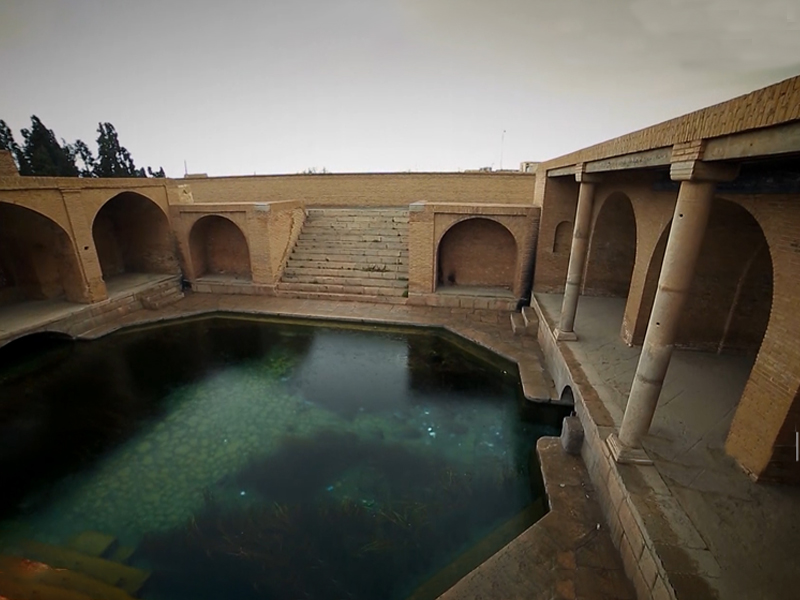
Related post
Introduction of 20 Best Tourist Attractions in Kashan
Traces of a 7,000-Year Civilization in the Sialk Mounds of Kashan
Access to Fin Garden, Kashan
Visiting Hours:
From the first six months of the year: 09:00 to 18:30
From the second six months of the year: 09:00 to 16:00
Address:
Fin Garden is located in Kashan, Isfahan Province, in the central part of the city. The address is Qasbe Fin Kuchak, from the village of Fin, Amir Kabir Street.
Final words
The Fin Garden’s historical significance is equally remarkable. It has witnessed significant events, from the assassination of Amir Kabir to the patronage of various rulers throughout the centuries. Each corner of Fin Garden tells a story, whether it’s the Safavid Pavilion, the Shah’s Chamber (Shahneshin room), or the Qajar Pavilion. Beyond its historical and architectural marvels, Fin Garden provides a retreat for nature lovers. The meticulously manicured lawns, vibrant flowers, and flowing fountains create a harmonious blend of human design and natural beauty.
FAQ
-
What is the Fin Garden in Kashan?
The Fin Garden is a historical Persian garden located in Kashan, Iran. It is a UNESCO World Heritage Site and is renowned for its stunning architecture, lush greenery, and tranquil ambiance.
-
How old is the Fin Garden?
The Fin Garden has a rich history dating back to the 16th century, during the reign of Shah Abbas I of the Safavid dynasty. It is over 400 years old and has retained its beauty and elegance throughout the centuries.
-
What are the main attractions within the Fin Garden?
The Fin Garden features several notable attractions, including the central pavilion known as the “Kakh-e Fin” or “Fin House,” which showcases exquisite architectural details. The garden also encompasses beautiful pools, fountains, and pathways, as well as a historical bathhouse known as the “Hammam-e Fin.”
-
How can I get to the Fin Garden in Kashan?
The Fin Garden is located in Kashan, a city in central Iran. Visitors can reach Kashan by various means of transportation, including by car, bus, or train. Once in Kashan, the Fin Garden is easily accessible by taxi or private vehicle. Local tour operators and guides can also provide transportation and guided tours to the garden.
